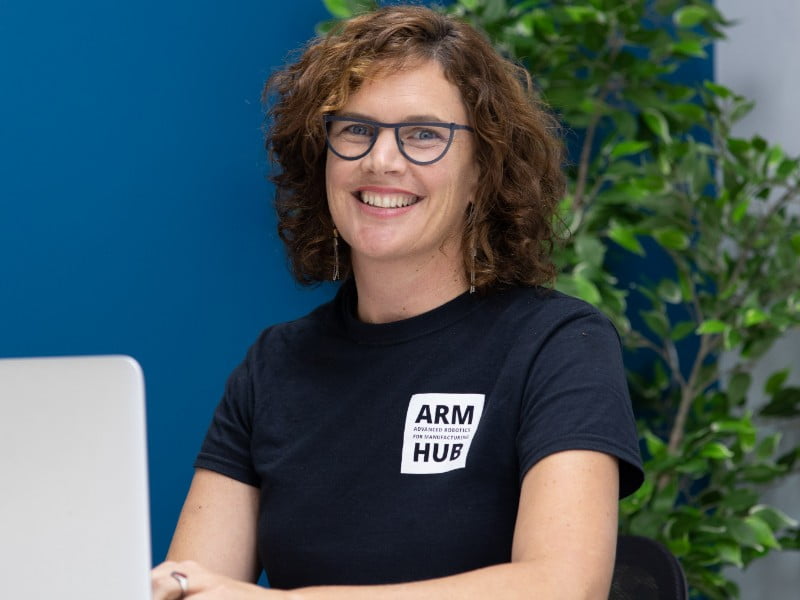The Advanced Robotics for Manufacturing Hub in Brisbane is the first independent manufacturing innovation hub in Australia to receive approved research institute status, two years after its establishment.
The Advanced Robotics for Manufacturing (ARM) Hub’s new status was approved by CSIRO and allows the robotics, AI, and design-led manufacturing centre to undertake its own in-house research projects. This will take place alongside the existing commercial services, including project management, engagement, and learning services.
Before becoming an approved research institute, the hub had to run research projects through its university partners.
Currently, the hub works with around 50 researchers on a project-by-project basis. IP generated through a partnership with the ARM Hub is generally retained by the partner to facilitate commercialisation, unless specified otherwise by a research program.

The hubs aim is to de-risk technology adoption, development, and commercialisation through its network of experts, university partners, and CSIRO partners.
Working with a large number of Australian technology companies, the ARM Hub is also a member of the World Economic Forum and has a global tech partnership with Microsoft. It also undertakes research programs with research institutions and universities based overseas.
The ARM hub has raised more than $40 million project funding for industry through research grants, industry grants, and private investment since it was established in 2020. ARM Hub chief executive Dr Cori Stewart anticipates the fund raising rate to increase to $30 million a year now that it is an approved research institute.
Dr Stewart said that although there is a history of medical institutes becoming approved research institutes (ARI), as far as she is aware the ARM Hub is the first independent not-for-profit ARI in broader scientific and technical areas.
Dr Stewart puts this down to a lack of investment in the Australian manufacturing industry.
“Australia has invested really poorly and hasn’t had long strategic oversight of what the manufacturing industry really needs to do industrial transformation,” Dr Stewart said.
She added that the ARM Hub is based on the practices of Catapult innovation centres in the United Kingdom and United States Manufacturing Institutes. Independent entities with big budgets in Sweden, Israel, Singapore, and Canada also help engage “research capabilities in a commercial setting with industry and smart tech companies to accelerate and scale up manufacturing”.
“Australia’s never had that infrastructure. It’s never had that ongoing investment view and the scale of investment that these examples have had and that over time have shown enduring success in building a manufacturing industry,” Dr Stewart said.
“[We need to] look at these successful models and really think hard about how we can do a systems change because I would argue that the system is broken in Australia at this point in time.”
In particular she said that manufacturing investments under the previous federal government were “a little bit disjointed”. Dr Stewart has high hopes for the Albanese government’s promised $15 billion National Reconstruction Fund and the “possibility that it will have a longer-term view of what’s possible for this country in terms of manufacturing outcomes and sustainability”.
As R&D investment in Australia continues to decline across the private, public, and university sectors, Dr Stewart said innovation hubs such as the ARM hub can provide some relief. However, she stressed that when “industry seeks to invest, others will follow”.
“What the ARM Hub does is that the outcomes and systems around it are tailored to get the outcomes that industry needs. You can’t sort of institute it from a university or government level, it has to be industry driven. So we need structures like the ARM hub and hopefully there’ll be more coming that will prioritise what industry needs.
According to the Organisation of Economic Cooperation and Development, more than 99 per cent of enterprises in Australia are small to medium-sized enterprises (SMEs). Dr Stewart says they’re unlikely to have access to typical research infrastructure and grants that universities like to invest in. She said that universities prefer investments over multiple years, which “is just not the reality of an SME”.
“So much can happen to SMEs and smaller enterprises. They may actually pivot or make really big changes in what their business is doing and how they’re doing business. They can’t commit to always being on a technology development and commercialisation path over say three to five years’ time,” Dr Stewart said.
In the short term, the hub will continue its defence and medical programs. It will also look to help companies meet their net-zero emissions ambitions.
Do you know more? Contact James Riley via Email.

